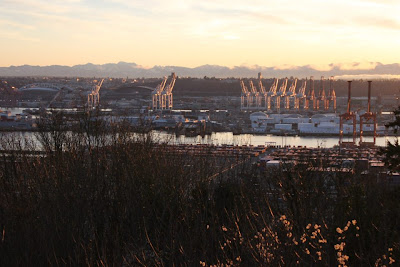I’m never really sure what to say when people ask me where
I’m from. The short answer is always, Orting,
Washington. This answer used to get a couple of pauses and a brief, “awe,
where is it located exactly?” Like I frequently do after receiving a puzzled
look, let me give you my Orting pitch to help you understand this little town
nestled arguably dangerously
close to Mount Rainier.
 Orting is a picturesque town in a lot of ways. As it was once described to me it’s an island
of sorts which sits between two major rivers – the Puyallup and Carbon. Both flow down
from Mount Rainier. On clear days the mountain will take your breath away with its
scale and varying colors which change with the sun and weather conditions.
Orting is a picturesque town in a lot of ways. As it was once described to me it’s an island
of sorts which sits between two major rivers – the Puyallup and Carbon. Both flow down
from Mount Rainier. On clear days the mountain will take your breath away with its
scale and varying colors which change with the sun and weather conditions.
As a former rail stop between a few
mining towns further east, Orting has a distinctive “downtown” core which spans
a few blocks located near the old station. While no urban metropolis, it offers
up a mix of amenities including a local drug store, library (my name is
actually engraved on a clock located here), Mexican restaurant, and a few other small
shops. The downtown is split in half by the City Park. When I was growing up
the park was the place to be during Orting’s few city specific festivals such
as Red
Hat Day, Summer in the Park, and the yearly Daffodil Festival.
My favorite part of the town is the extensive bike trail
which runs all the way from Puyallup
to South Prairie. When my older brother
and I became farm hands one summer on a local raspberry farm we used the trail
to commute. In the early mornings after we were done picking berries my brother
and I would race down the trail back home and then eventually to Blockbuster to
rent video games.
Past the town parts of Orting the rail reaches back into the woods and runs adjacent to the Puyallup River for miles along an old railroad track. The calming nature of the woods is enough to make even the most stressed person relax.
Past the town parts of Orting the rail reaches back into the woods and runs adjacent to the Puyallup River for miles along an old railroad track. The calming nature of the woods is enough to make even the most stressed person relax.
 And I can’t forget about the Lion’s Club field located
just on the outskirts of town. It’s not much more than a giant patch of grass
with a few lines setup for soccer but it’s an amazing place to be during the
Fourth of July. The whole town usually comes out for the event and you start to
ask yourself, “is this town really so small?”
And I can’t forget about the Lion’s Club field located
just on the outskirts of town. It’s not much more than a giant patch of grass
with a few lines setup for soccer but it’s an amazing place to be during the
Fourth of July. The whole town usually comes out for the event and you start to
ask yourself, “is this town really so small?”
While I spent my high school years in Orting it’s not my
original home. Throughout childhood my family lived in many places along the Puget
Sound including Seattle, Federal Way, and Kent. Orting was our final
destination. While I often hate to admit it at times, wishing I was from
somewhere “cooler,” more “cosmopolitan,” or “famous,” Orting is where I hang my
hat and call home.
It’s the place I became a “track star,” my father achieved his dream of becoming a city councilmen, and my family established a name for itself. Like many things in this world, meaning is derived from context; for me that means where I’m from has varying degrees of complexity but the short of it is, I’m from Orting.

It’s the place I became a “track star,” my father achieved his dream of becoming a city councilmen, and my family established a name for itself. Like many things in this world, meaning is derived from context; for me that means where I’m from has varying degrees of complexity but the short of it is, I’m from Orting.






